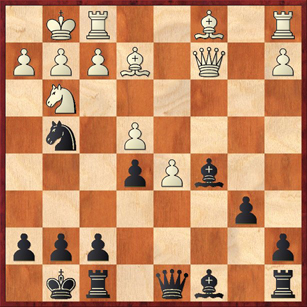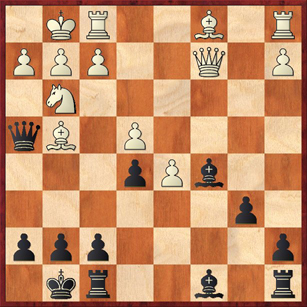After playing well in chess club my last two times, I guess I was due for an off night. I was in the top quad with Juande Perea and Dan Burkhard (who are both playing in the Santa Cruz Cup) and Steve Sullivan. First round was a lifeless draw as Black against Juande. Okay, I can live with that. Second round was a skin-of-my-teeth draw against Steve.
Steve totally surprised me in this game. We got to an endgame that was dead drawn, with nothing either of us could really do to play for a win… but I had only 10 seconds left, while he had oodles of time, at least five minutes. So of course I’m going to lose on time, but to my surprise he offered me a draw. He explained, “I like to feel as if I earned my wins.” I thanked him and told him I thought he was very sportsmanlike to offer the draw. But now I have to take back what I wrote about him in my previous entry. (Remember, I said that he has the mind of a hustler and is glad to win any way he can.)
My third-round game against Dan was the most interesting, from both the chess and psychological point of view. I’ll give you two quiz positions, only one move apart.
Dan Burkhard – Dana MackenzieÂ
1. d4 Nf6 2. c4 d5 3. Nc3 c5 4. cd Nxd5 5. e4 Nxc3 6. bc cd 7. cd e5! (ChessLecture subscribers will recognize this line from my lecture, “Fun with a Supposedly Inferior Variation.” Dan, of course, had never seen it before.) 8. d5 Bc5 9. Qc2 Nd7 10. Bd3 b6 11. Ne2 O-O 12. Ng3 … (This plan seems too slow. He should have just played 11. Nf3 and 12. O-O.) 12. … Nf6 13. O-O Ng4! (Here I thought I was going to win quickly, but I seriously overrated my position.) 14. Be2 …
First quiz position: What should Black play? (Be careful!)
The move I actually played was 14. … Qh4, to which Dan naturally replied 15. Bxg4. That brings us to our next quiz position:
Which way should Black recapture, and why?
Here the position is really about equal, but I continued to labor under the delusion that Black had a significant advantage. So I threw my pawns forward on the kingside, as in the King’s Indian Defense, while Dan calmly played for positional advantages — he traded off dark-squared bishops, took control over the c-file, put his queen on the a2-g8 diagonal, and finally played d6 and Nd5… all of which I allowed him, because I thought I was going to checkmate him on the kingside. It didn’t happen, and he got to an easily winning endgame. It was really a very nice comeback by Dan from a bad-looking position. For me, it was a failure to achieve the calm objectivity one needs in chess. To some extent my lack of calm may have been a hold-over from the round before, when I had that frenetic time scramble against Steve Sullivan that ended with Steve graciously giving me a draw. I got in pretty bad time trouble this game, too, which didn’t help.
Answer to first quiz question: Did you say 14. … Nxh2? If so, you have a sharp eye for tactics but you need to remember to analyze them all the way to the end. In fact, 14. … Nxh2?? loses to 15. Kxh2 Qh4+ 16. Kg1 Qxg3 (this was supposed to be the point) 17. Qxc5! and no matter what Black does, White ends up a piece ahead. So in fact the move I played, 14. … Qh4, was Black’s best followup.
After the game, Dan said that I should have played 14. … Nxh2! He did not see White’s countersacrifice 17. Qxc5!, and I had to show it to him. So maybe I would have won if I had played the inferior move, but of course there is no way that you can play an outright blunder, counting on your opponent not seeing the refutation.
Answer to second quiz question: Here I played 15. … Bxg4?, which I think was the wrong way to take. The computer rates the two captures equal, which I think is also incorrect. 15. … Qxg4 is better because Black has a clear plan of playing … h5 and … h4, or possibly … f5. With the move I played, I never had a clear plan of attack: the game continued 15. … Bxg4 16. Qd3 Bd4 17. Rb1 g6 18. Be3 Bxe3 19. Qxe3 and White was fine. In fact, Fritz says that White is already significantly better.
After the game we analyzed 15. … Qxg4 and concluded that Black was doing quite well after 16. Qd3 h5 (16. … f5 is also a serious possibility, which Fritz prefers) 17. Be3 Bxe3 18. Qxe3 h4 19. h3 Qg6 20. Ne2 Ba6.
This was an error due to conventional thinking. I looked seriously at 15. … Qxg4, but finally I took with the bishop because “it seems right to develop a piece.” But there are good reasons not to develop the bishop yet. It never really had a future on g4, and on that square it just got in the way of the queen. With the queen and bishop failing to cooperate, it was harder for Black to play … f5 (to prepare it, I had to play the time-wasting, weakening 17. … g6). And on c8, the bishop retains the important option of going to a6. Instead of thinking dynamically (Where do I want my pieces to go? What do I want them to do?) I thought ritualistically (Finish your development, then decide what to do next).
If you got both of these quiz questions right, good for you! They’re definitely harder than the ones I gave you the last two times. In part that’s because they are more normal chess positions. Instead of “Black to play and win,” it’s “Black to play and resist temptation,” or “Black to play and set up a reasonable plan of attack.” These are harder decisions to make!





{ 1 comment… read it below or add one }
In the first quiz I would have avoided Nxh2 not so much by calculating the continuation but because I’ve seen that Queen-takes-pinning-bishop somewhere before; I thus “knew” it.
In the second example I would have recaptured with the Bishop without thinking. The develop a piece rationalization is too good an excuse for taking a rest from calculation and/or planning.